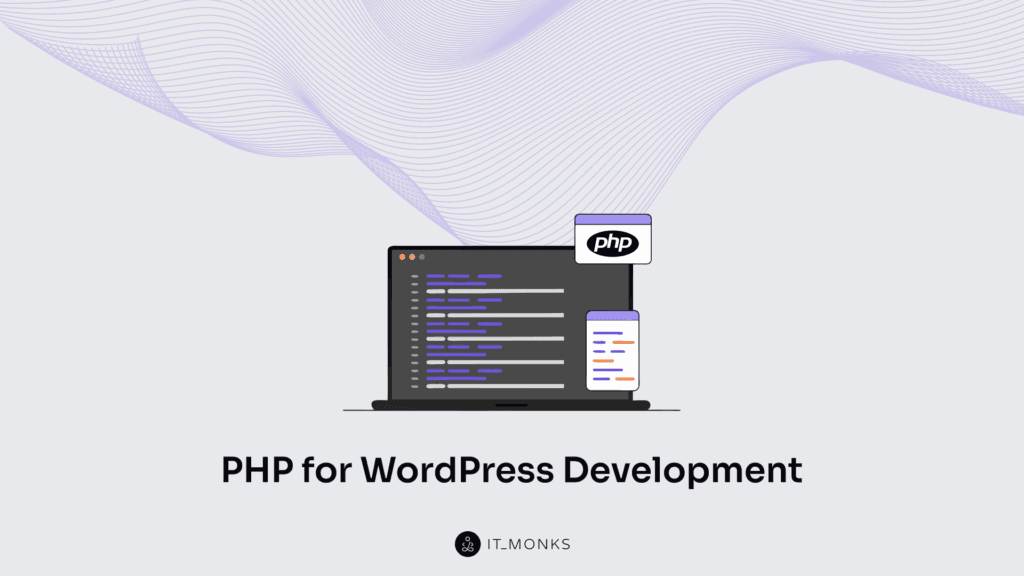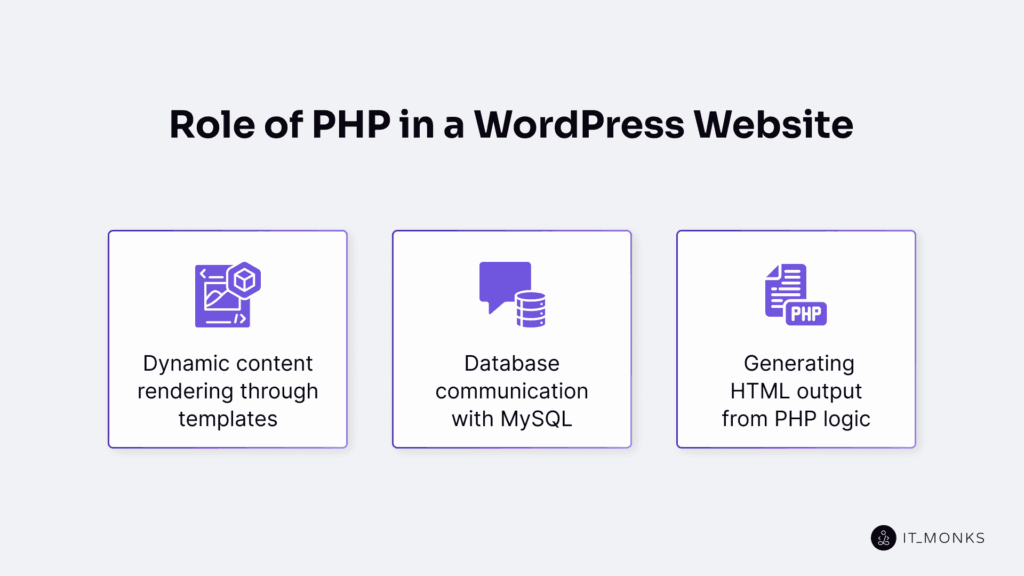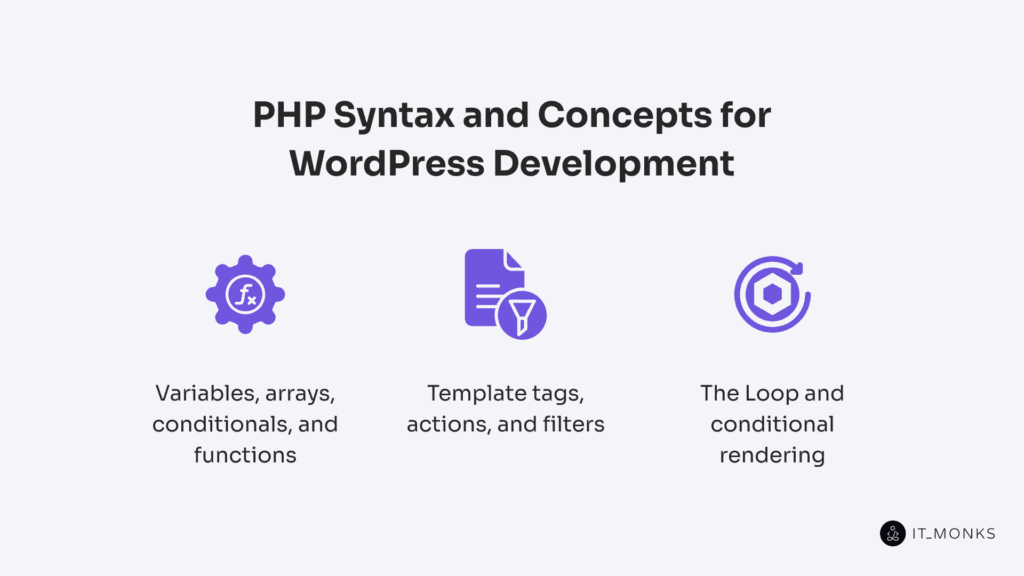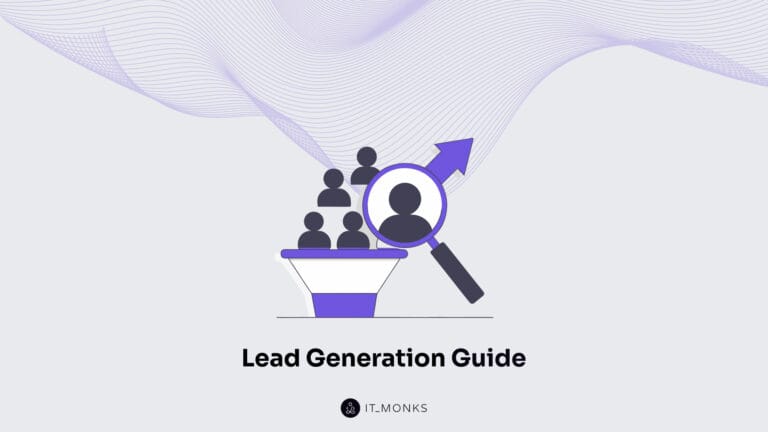PHP for WordPress Development
Table of Contents

WordPress website executes and integrates PHP logic across every operational layer, defining its server-side behavior, content rendering, and architectural design. It processes requests and delivers dynamic content through a PHP-based templating system that communicates with MySQL to retrieve and modify data in real time.
WordPress website relies on PHP to generate HTML output for themes and templates, execute plugin logic, invoke theme functions, and run the hook system that drives actions and filters. This dependency extends from request routing to final content rendering, forming a lifecycle shaped by PHP-driven control flows.
Through continuous PHP mediation, WordPress website unifies its templating, plugin, and theme environments into a single execution layer that sustains coherence throughout each request and response. Within this framework, PHP governs the boot files, plugin activations, and theme rendering routines through its event-based structure.
For WordPress developers, understanding PHP is essential because it is the language through which the WordPress website structures, executes, and delivers all dynamic behavior.
What is PHP?
PHP is a server-side scripting language that runs backend logic in response to HTTP requests, operating as an interpreter within the runtime environment of web servers like Apache or Nginx. It executes procedural and object-oriented code to generate dynamic web pages through embedded scripting and HTML output.
In WordPress, PHP functions as the core execution layer; it parses templates, handles form submissions, and renders content by interfacing with MySQL databases. Because PHP is interpreted at runtime, it integrates tightly with WordPress’s templating engine, plugin system, and request lifecycle.
As an open-source language, it powers the WordPress core by processing configuration files, resolving routing logic, and executing rendering pipelines, making it essential to the CMS’s structure and functionality.
What Is the Role of PHP in a WordPress Website?

PHP drives the server-side execution flow of a WordPress website, handling everything from loading templates to delivering HTML output. It executes theme and plugin logic, retrieves content from the MySQL database, parses template files, and assembles the final user-facing page.
WordPress depends entirely on PHP to transform stored data and configuration into dynamic web content; every page served is the result of PHP handling the full request-response cycle. These operations fall into 3 distinct roles: dynamic template rendering, backend database communication, and structured HTML generation.
Dynamic content rendering through templates
In WordPress, templates are PHP-executed files that render dynamic content based on runtime input. When a user visits a page, such as a post, archive, or custom post type, PHP processes the request and selects the appropriate template from WordPress’s internal template hierarchy (e.g., single.php, archive.php, page.php).
Once the file is selected, PHP injects content into the template using built-in functions like get_header(), the_title(), and the_content(). These functions retrieve data and populate the template structure with context-specific output, guided by conditional logic based on URL paths, query variables, or page type.
Because PHP controls the rendering logic, a single set of theme files can dynamically generate a wide variety of views. This allows WordPress to deliver tailored content without duplicating templates, using a consistent, backend-driven execution flow.
Database communication with MySQL
PHP acts as the communication layer between WordPress and its MySQL database. When a user requests a page, PHP builds a structured query, based on the requested content, such as posts, settings, or user data, and sends it to MySQL. MySQL returns the data, which PHP then processes and stores for template rendering.
This PHP-driven query-response cycle powers every WordPress page load. Built-in functions like get_posts(), get_option(), and $wpdb->get_results() let PHP issue precise queries without requiring raw SQL. For example,
$wpdb->get_results( "SELECT * FROM $wpdb->posts WHERE post_status = 'publish'" )shows PHP directly retrieving published posts.
All retrieved content is held in PHP memory, ready for use in templates. Without this backend interaction between PHP and WordPress database, WordPress couldn’t deliver dynamic, database-driven content on demand.
Generating HTML output from PHP logic
PHP generates the final HTML output for WordPress pages by executing logic embedded in templates at runtime. This process doesn’t serve static HTML files; instead, PHP evaluates conditions, injects dynamic content, wraps it in presentational tags, and returns the complete markup to the browser. HTML shown to users is dynamically generated during each request.
Template logic includes conditional checks, such as if (have_posts()), and output functions, such as the_title() and the_content(). These functions aren’t just placeholders; they produce fully structured HTML by combining data with predefined markup. For example, the_title() may output a post title inside an <h1> element, while the_content() builds the post body with semantic tags.
This dynamic rendering allows the same template to produce different HTML depending on the request context, such as user role, URL, post type, or query parameters. PHP assembles the output per request, adapting content and layout in real time.
As the final step in the server-side rendering chain, PHP executes the logic, merges data, and returns the full HTML response, completing the request-response cycle.
A simple example:
<?php if ( have_posts() ) : while ( have_posts() ) : the_post(); ?>
<h2><?php the_title(); ?></h2>
<div><?php the_content(); ?></div>
<?php endwhile; endif; ?>Each line shows how PHP dynamically controls both the content and the structure on each page load.
How Does PHP Power the WordPress Core?
PHP forms the execution engine behind the entire WordPress core. It loads essential configuration files, sets up the runtime environment, and directs how content is processed through templates, themes, and plugins.
From start to finish, PHP executes a layered structure of code: the core engine, active theme, and installed plugins. Each layer is triggered by PHP in a specific sequence, based on the request and environment.
This structured orchestration provides the foundation for WordPress backend development, where PHP manages initialization, logic execution, and data flow across system layers.
This implementation begins with key bootstrap files, such as wp-config.php, wp-settings.php, and index.php, which PHP uses to launch WordPress.
System layers: core, themes, and plugins
WordPress is structured into 3 execution layers, such as core, themes, and plugins, all executed in sequence by PHP. PHP first initializes the WordPress core, which sets up the system environment, handles routing logic, and configures database connectivity and CMS-level behavior.
Once the core is bootstrapped, PHP loads the active theme, executes its template hierarchy, and retrieves layout logic via functions such as get_header() and get_template_part(). After the theme is loaded, PHP activates plugin functionality by triggering the registered hooks, actions, and filters defined within each plugin module.
By executing the core first, then the theme, and finally the plugins, WordPress establishes a modular architecture in which each layer hooks into the request lifecycle via PHP’s execution logic. Because each layer builds on the environment established by the one before it, PHP’s sequential execution ensures the core sets the global context, themes apply layout logic, and plugins inject extensible behavior without destabilizing the system.
The layered execution ensures extensibility while preserving the core’s stability and consistent runtime behavior.
Boot and config files: wp-config.php, wp-settings.php, index.php
PHP initializes the WordPress boot process by executing 3 core bootstrap files that collectively set up and configure the environment. PHP executes index.php, the entry point script that routes incoming HTTP requests into the WordPress system. It loads wp-config.php to define system constants, such as database credentials, authentication salts, and environment variables like debug modes, marking the configuration phase.
Next, PHP executes wp-settings.php to assemble the runtime environment by initializing the core, loading core hooks, and activating the plugin and theme subsystems.
Each file serves a distinct purpose in the boot sequence: routing logic originates in index.php, configuration constants are defined in wp-config.php, and system components, including core hooks, plugins, and themes, are activated via wp-settings.php.
How Is PHP Executed During the WordPress Request Lifecycle?
PHP starts WordPress boot process by executing 3 core files in a strict sequence to set up the environment. It starts with index.php, the public entry point that routes incoming HTTP requests into the system.
PHP then loads wp-config.php to define configuration constants like database credentials, salts, and debug settings. Finally, it runs wp-settings.php, which initializes the core, loads hooks, and activates themes and plugins.
This execution order, such as route, configure, and load, enables PHP to bootstrap the full WordPress environment on every page request.
Request routing and environment loading
PHP handles every incoming HTTP request by routing it through index.php, the front controller of WordPress. It interprets the request path, selects the appropriate internal logic, and triggers the boot sequence that initiates server-side control flow.
Next, PHP loads the core configuration files, such as wp-load.php, wp-config.php, and wp-settings.php, to define essential constants, set environment variables, and establish database parameters. It builds the runtime stack, sets the global execution state, and prepares key objects like $wp and $wp_query.
By routing the request, loading configurations, initializing the environment, and preparing system state, PHP constructs the full execution context that enables WordPress to proceed with dynamic rendering through templates and hooks in the next lifecycle phase.
Template loading, actions, and filters execution
After the WordPress environment is initialized, PHP determines which template to run based on the current query. Using the template hierarchy, PHP selects the proper file, such as single.php, archive.php, or 404.php, and executes it to begin dynamic rendering.
During this process, PHP triggers actions such as wp_head and wp_footer at defined points in the runtime, where it executes additional routines from themes or plugins to extend the default behavior. At the same time, PHP applies filters such as the_content or excerpt_length, modifying data before it is output.
By loading the correct template, triggering registered actions, and applying filters, PHP completes the WordPress execution lifecycle, ensuring all theme logic and content adjustments are resolved before it renders the final HTML response for the browser.
Which PHP Syntax and Concepts Are Essential for WordPress Development?

PHP syntax forms the foundation of WordPress development, using variables to store runtime data, arrays to group function arguments, conditionals to control logic, and user-defined functions to organize reusable operations. Such elements define how themes, templates, and plugins manage content, configuration, and behavior.
In practice, these principles are guided by established code standards in WordPress development, which ensure consistency, readability, and compatibility across themes and plugins. WordPress builds on this base with its own PHP-driven constructs: template tags run predefined functions within themes, action and filter hooks modify logic at runtime, and the Loop (which is executed in PHP) cycles through posts to generate dynamic output.
Variables, arrays, conditionals, and functions
PHP uses variables, arrays, conditionals, and functions as the core tools that structure and execute WordPress behavior. Variables store runtime data, such as post IDs, query results, or user roles, and maintain global values shared across templates, plugins, and user interactions.
Arrays, especially associative and argument arrays, organize grouped configuration data that WordPress functions and template tags use to determine output, register hooks, or define settings. Conditionals control the logic flow within theme and plugin files, enabling PHP to adjust behavior based on context, such as switching layouts, filtering content, or validating user access.
Functions encapsulate reusable logic that defines template operations, attaches plugin callbacks, and extends system features through user-defined execution.
Template tags, actions, and filters
WordPress extends PHP’s function model through 3 runtime constructs, such as template tags, action hooks, and filter hooks, that PHP executes to control dynamic output and extensible behavior across themes and plugins.
In templates, PHP executes WordPress-defined template tags, such as the_title() and the_content(), to retrieve and display dynamic content. These callable functions bridge PHP logic with HTML rendering inside theme files.
PHP runs action hooks at specific points in WordPress’s lifecycle, such as wp_head or init, to inject additional behavior such as loading scripts, initializing plugins, or modifying headers without altering the core system.
PHP applies filter hooks to modify data before it is returned or displayed. Each content filter acts as a transformation layer, allowing PHP to adjust post titles, excerpts, or other values before final output.
Across all 3 mechanisms, PHP is the active engine: it executes the functions, applies transformations, and directs the output flow. WordPress defines the structure of these hooks, while PHP performs every operation at runtime, making this integration the foundation of WordPress’s extensibility and runtime customization in themes and plugins.
The Loop and conditional rendering
PHP executes the Loop to process posts returned by the WordPress query system, evaluating each result at runtime and rendering its content dynamically within the theme template. Through the whole structure that calls have_posts() and the_post(), PHP exposes the current query object, binds its variables to the template scope, and generates post output, such as titles, excerpts, and metadata, under its direct control.
Within or around this loop, PHP applies conditional logic to decide what to display. Using if and else statements along with WordPress conditionals like is_single(), is_category(), and is_user_logged_in(), it evaluates the runtime context and determines which template sections to render, skip, or modify.
These conditionals act as real-time filters, guiding PHP’s rendering flow according to post type, query parameters, and user state.
Both the Loop and its conditionals form part of WordPress’s template execution phase, where PHP governs every rendering decision.
How Is PHP Used in Themes and Plugins?
In themes, PHP executes the code logic defined in template files such as index.php or header.php, structuring layout and dynamically rendering content through functions, conditionals, and modular HTML output.
In plugins, PHP functions as the runtime engine that executes event-driven logic through hooks and callback functions. It registers hooks, defines callback functions, and injects code logic into WordPress through the event-driven hook system. When an action or filter is triggered, PHP executes the assigned callbacks to modify data flow or extend functionality.
Across both layers, PHP unifies structure and behavior by rendering what users see in themes and executing the system’s behavior through plugins.
Theme file structure and functions.php
A WordPress theme is a structured system of PHP files that control how site content is rendered. PHP executes template files, like index.php, single.php, and page.php, based on WordPress’s template hierarchy, loading each one according to the request context.
This system follows the WordPress file and directory structure, where every component, including core, theme, and plugin, resides in a specific path that defines how WordPress locates and runs PHP templates. WordPress maps every request to the correct PHP template, and PHP runs that file to produce the final output dynamically, ensuring pages are generated through logic.
At the core, functions.php serves as the theme’s main logic controller. PHP runs this file when the theme loads to register menus, sidebars, and features, enqueue scripts and styles, and connect to WordPress actions and filters.
Through these executions, PHP injects runtime behavior into WordPress, allowing the theme to modify site functions without changing the core.
In this file-based system, PHP governs both the structure and behavior of the theme, directing how templates render content and how functions.php manages the dynamic logic that unifies theme operations.
Plugin skeleton and hook-based behavior
Plugins in WordPress are PHP-based execution modules that extend the platform through hook registration. PHP loads the main plugin file as the structural entry point, using the plugin header metadata, such as name, version, and author, to identify and register the plugin during the WordPress lifecycle.
From this file, PHP defines the plugin’s behavioral logic by registering callback functions to action and filter hooks with add_action() and add_filter(). Each callback is mapped to a hook name, such as init, wp_enqueue_scripts, or save_post. When WordPress fires a hook, PHP executes the corresponding function, injecting the plugin’s behavior into the runtime environment.
The plugin skeleton provides structure, while PHP controls behavior through the hook-based system.
By loading the plugin file, registering callbacks, and executing logic as hooks trigger, PHP governs both the plugin’s structure and its runtime behavior, making the plugin skeleton its framework and the hook mechanism its behavioral engine.
How to Secure and Maintain PHP Code in WordPress?
To secure and maintain PHP code in WordPress, PHP itself provides protection, ensures compatibility, and supports runtime diagnostics. As the active execution engine, it validates and escapes data through functions like sanitize_text_field() and esc_html() to prevent vulnerabilities such as cross-site scripting or SQL injection.
Beyond security, PHP maintains system integrity by detecting deprecated functions and adapting to newer core versions, allowing older plugins and themes to remain functional as the platform evolves.
It also provides runtime visibility with tools like WP_DEBUG and error logs, exposing faults and configuration issues before they affect performance.
Input sanitization and escaping output
PHP protects WordPress by cleaning user input and escaping output before sending it to the browser. Acting as WordPress’s runtime engine, PHP validates data at entry and encodes it at delivery, maintaining a secure barrier between user data and core execution.
During input handling, PHP filters user values to remove invalid or unsafe content before they reach WordPress logic or the database. Functions such as sanitize_text_field() provide WordPress-level interfaces, but the actual validation and normalization are executed by PHP itself.
At the output stage, PHP escapes generated content so it’s displayed as text rather than executable code. Using routines like esc_html() and esc_attr(), PHP converts special characters into HTML entities to prevent cross-site scripting and similar attacks.
Input filtering and output escaping work together as part of PHP’s runtime behavior, not as optional coding steps. By automatically enforcing these controls, PHP preserves data integrity and protects WordPress applications from corruption and injection attacks.
Handling deprecated functions and version issues
PHP manages deprecated functions and version compatibility to keep WordPress stable across updates. At runtime, PHP executes deprecated functions for backward compatibility while triggering runtime warnings and WP_DEBUG notices that alert developers to legacy code. These signals mark outdated functions for replacement with modern APIs or supported syntax.
PHP maintains backward compatibility by running fallback logic when new PHP or WordPress versions introduce breaking changes. Each deprecated function stays active until developers adopt an alternative API, following a clear function lifecycle from execution to removal. During version updates, PHP adapts the execution flow, enforces stricter syntax rules, and issues runtime warnings to prevent version mismatch.
Developers ensure forward compatibility by replacing deprecated calls with updated PHP functions or WordPress APIs. This ongoing runtime maintenance process, where PHP detects, warns, and executes conditional logic, preserves code stability and keeps WordPress secure, predictable, and maintainable through continuous evolution.
Debugging with WP_DEBUG and error logs
PHP enables real-time debugging in WordPress by making errors visible via the WP_DEBUG constant and logging execution errors to the error log. When WP_DEBUG is active, PHP exposes deprecated function calls, runtime notices, logic warnings, and undefined variables, outputting stack traces and execution messages during theme and plugin execution. Here is an example:
define( 'WP_DEBUG', true );To extend this further, WP_DEBUG_LOG can be activated to save these messages to a debug log file (wp-content/debug.log), which helps track persistent issues over time:
define( 'WP_DEBUG_LOG', true );PHP also captures persistent issues in its error logs, recording syntax errors and runtime failures across all plugin and theme environments. These logs trace the exact file and logic layer where faults occur, allowing precise fault isolation.
Together, these tools ensure full visibility into execution flow, prevent silent failures, and support proactive debugging by keeping WordPress sites stable during development and deployment.
Contact
Don't like forms?
Shoot us an email at [email protected]




